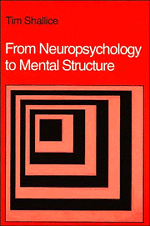Book contents
- Frontmatter
- Contents
- Preface
- I Introducing Cognitive Neuropsychology
- 1 From the Diagram-Makers to Cognitive Neuropsychology
- 2 The Cognitive Neuropsychology Approach
- II Converging Operations: Specific Syndromes and Evidence from Normal Subjects
- III Inferences from Neuropsychological Findings
- IV Central Processes: Equipotentiality or Modularity?
- References
- Subject Index
- Author Index
- Index of Patients Cited
1 - From the Diagram-Makers to Cognitive Neuropsychology
from I - Introducing Cognitive Neuropsychology
Published online by Cambridge University Press: 21 October 2009
- Frontmatter
- Contents
- Preface
- I Introducing Cognitive Neuropsychology
- 1 From the Diagram-Makers to Cognitive Neuropsychology
- 2 The Cognitive Neuropsychology Approach
- II Converging Operations: Specific Syndromes and Evidence from Normal Subjects
- III Inferences from Neuropsychological Findings
- IV Central Processes: Equipotentiality or Modularity?
- References
- Subject Index
- Author Index
- Index of Patients Cited
Summary
Why Neuropsychology?
For 100 years, it has been well known that the study of the cognitive problems of patients suffering from neurological diseases can produce strikingly counterintuitive observations. From time to time, research workers studying normal function have been strongly influenced by such observations or by the ideas of the neurologists who made them. Bartlett (1932) and Hebb (1949) are two examples. However, in general, neuropsychology has had little impact on the study of normal function.
With any knowledge of the history of clinical neuropsychology, it is easy to understand why this neglect occurred. The standard of description of the psychological impairments of patients was low, often being little more than the bald statement of the clinical opinion of the investigator. There was frequently a dramatic contrast between the vagueness of the psychological account of the disorder and the precision with which anatomical investigation of the lesion that had given rise to it was carried out at post-mortem. Also, the field, like psychology itself, could agree on little but the most obvious and basic theories. Typical are the disputes about the existence of the syndrome visual object agnosia, a specific difficulty in the perception of objects when both sensation and the intellect are intact. The syndrome was widely accepted as real in the golden age of the flowering of neuropsychology (1860-1905) (e.g. Lissauer, 1890). Yet its existence was still being denied nearly a century later (e.g. Bay, 1953; Bender & Feldman, 1972).
- Type
- Chapter
- Information
- From Neuropsychology to Mental Structure , pp. 3 - 17Publisher: Cambridge University PressPrint publication year: 1988



